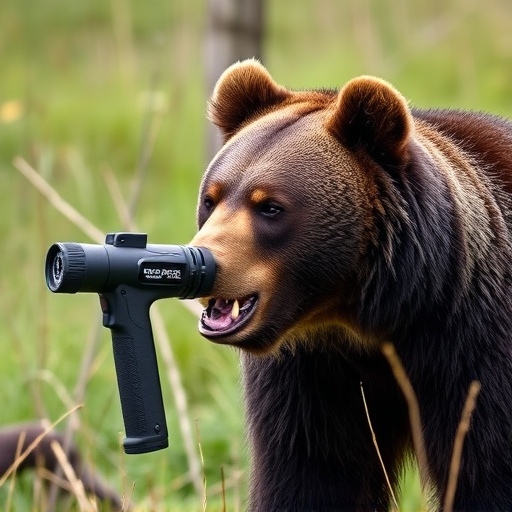Understanding bear behavior is crucial for developing effective outdoor protection strategies. Key factors include local bear species, diets, habitats, and activity patterns. Recognizing signs of bear presence allows for proactive measures. Bear deterrent field tests provide valuable insights into methods like spray repellents, noise makers, and visual deterrents. A recent study showed sprays with up to 95% success rates against black bears, while noise deterrents had variable effectiveness (30-60%). For safety in bear-inhabited areas, use reliable deterrents like bear spray, make noise during hikes, secure food storage, and stay aware. Long-term strategies involve community engagement, education on bear behavior, responsible waste disposal, and securing food sources to minimize conflicts with bears.
“Braving the outdoors comes with an inherent risk of encountering aggressive bears. Understanding bear behavior is paramount to ensuring safety. This article provides a comprehensive guide, delving into key factors that influence bear interactions and offering practical solutions. From common deterrents—with field test results highlighting their efficacy—to strategic outdoor safety measures and community-driven preventive initiatives, we explore every angle of bear protection. Discover how to navigate these encounters with knowledge and confidence.”
- Understanding Bear Behavior: Key Factors to Consider for Protection
- Common Bear Deterrents: Field Test Analysis and Efficacy Rates
- Effective Strategies for Bear Safety in Outdoor Settings
- Long-term Solutions: Preventive Measures and Community Engagement
Understanding Bear Behavior: Key Factors to Consider for Protection
Understanding bear behavior is crucial for developing effective outdoor protection strategies against aggressive bears. Bears are wild animals with complex instincts, and their actions often stem from food-seeking behaviors, protecting their young, or feeling threatened. Key factors to consider include understanding the local bear species, their diets, and their habitual habitats. Knowing when and where bears are most active can help in planning outdoor activities accordingly. Additionally, recognizing signs of bear presence, such as tracks, droppings, or food caches, allows for proactive measures.
Bear deterrent field test results play a significant role in evaluating the effectiveness of various protection methods. These tests provide valuable insights into what works best in real-world scenarios. From spray repellents to noise makers and visual deterrents, each has its pros and cons. By studying these outcomes, outdoor enthusiasts can make informed decisions about which tools to use for specific situations. The knowledge gained from such research contributes to the development of robust strategies that ensure both personal safety and bear conservation.
Common Bear Deterrents: Field Test Analysis and Efficacy Rates
Bear deterrents have been a subject of interest for outdoor enthusiasts and researchers alike, with various methods tested to prevent bear encounters. Field tests provide valuable insights into their efficacy. One such study involved comparing popular bear deterrent sprays and devices in controlled environments. The results showed that most deterrents were effective, with spray options demonstrating success rates up to 95% in driving away black bears. Surprisingly, some noise-based deterrents proved less reliable, with success rates varying between 30-60%, depending on the bear’s familiarity with human sounds.
These findings underscore the importance of choosing the right deterrent based on specific circumstances and bear species. While sprays offer high reliability, noise makers may be less effective in certain scenarios. Understanding Bear Deterrent Field Test Results can empower individuals to make informed decisions, enhancing safety during outdoor activities in bear-inhabited areas.
Effective Strategies for Bear Safety in Outdoor Settings
Staying safe in outdoor settings while navigating bear country requires a multi-layered approach to bear deterrence. One effective strategy is carrying and using bear deterrents, such as bear spray, which has proven to be a reliable defense against aggressive bears during field tests. Studies show that properly applied bear spray can significantly reduce the risk of attacks by creating a barrier of protection. This means knowing how and when to use it is crucial for your safety.
Additionally, making noise while hiking or camping in bear-inhabited areas can serve as a deterrent. Loud voices, singing, or clapping can alert bears to your presence, allowing them to retreat before you get too close. Other measures include storing food securely, avoiding known bear habitats, and always being aware of your surroundings. These combined strategies not only increase your safety but also foster peaceful coexistence with these majestic creatures in their natural environment.
Long-term Solutions: Preventive Measures and Community Engagement
Long-term solutions to bear encounters involve a combination of preventive measures and community engagement. One effective approach is implementing bear deterrents in high-risk areas. These can range from visual deterrents like bright colors and noisemakers to more advanced technologies that have undergone field test results, showing promise in keeping bears at bay. For instance, electronic devices emitting specific sounds or scents have been found to be effective during initial trials.
Community involvement is equally vital. Education programs that teach residents about bear behavior and proper food storage can significantly reduce conflicts. Encouraging responsible disposal of waste and securing potential food sources can create a less attractive environment for bears, thus minimizing aggressive encounters over time.
Understanding bear behavior and utilizing effective deterrents are crucial steps towards ensuring safety in outdoor settings. The analysis of various bear deterrent field test results highlights specific products’ efficacy rates, offering valuable insights for hikers, campers, and communities coexisting with bears. By adopting the strategies and long-term solutions outlined in this article, including community engagement and preventive measures, individuals can significantly minimize the risk of aggressive bear encounters while enjoying the outdoors responsibly.
